Business Communication Challenges and Solutions: Hilton Hotels Report
VerifiedAdded on 2021/02/19
|11
|2371
|54
Report
AI Summary
This report provides a comprehensive analysis of business communication within Hilton Hotels. It begins with an abstract that highlights the importance of effective communication between employees and subordinates within an organization, covering both formal and informal communication methods. The report then dives into various forms of organizational communication, including formal, informal, directional, internal, external, oral, and written communication. It explores the purpose behind these communication forms, emphasizing how they facilitate information flow and enable managers to plan, control, and maximize profitability. The report also identifies and analyzes common barriers to communication, such as organizational, personal, and perception barriers, offering strategies to overcome them, including clarity, timely information, and feedback mechanisms. The conclusion summarizes the key findings and recommends strategies for managers to ensure effective communication, ultimately promoting a harmonious workplace and organizational success.
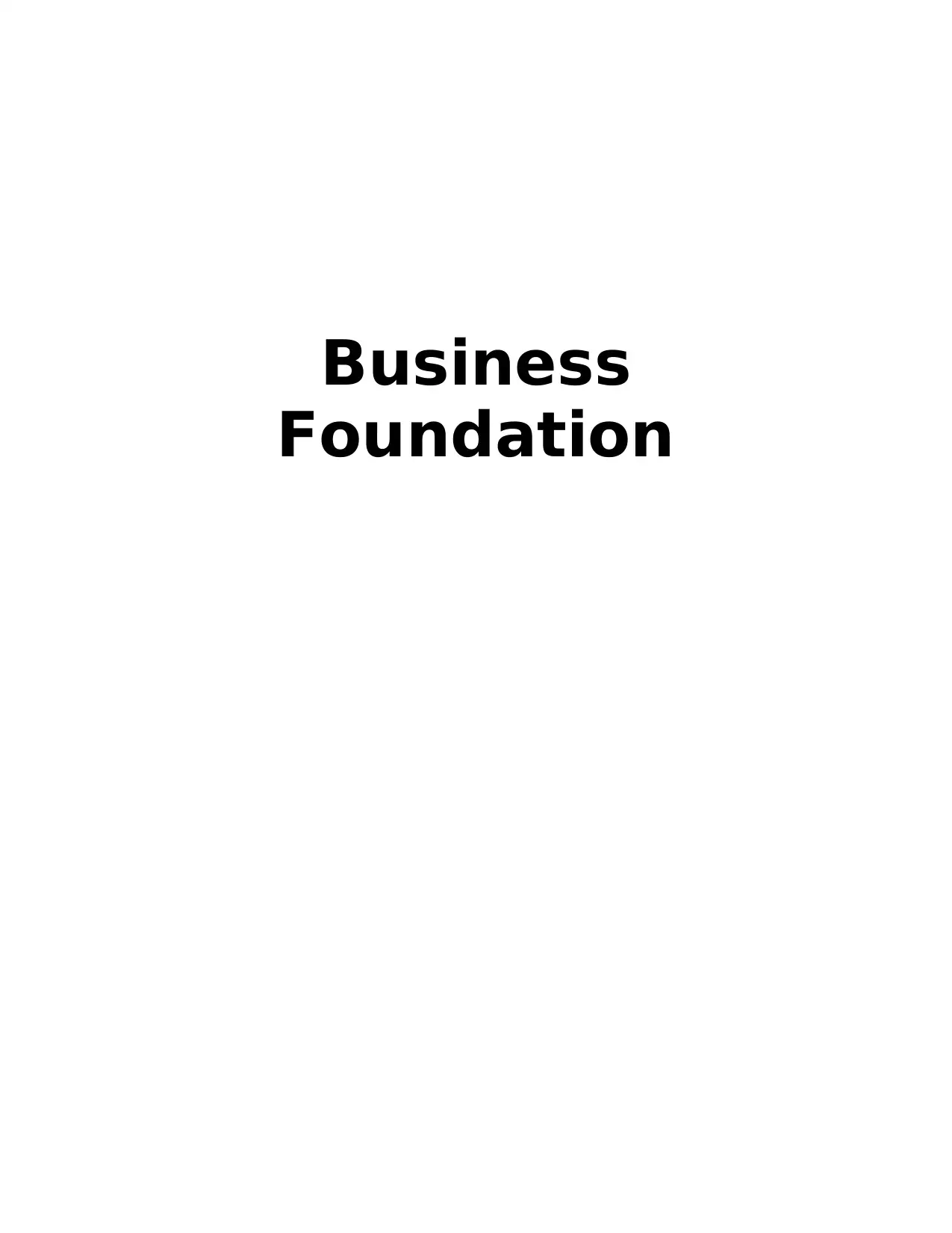
Business
Foundation
Foundation
Paraphrase This Document
Need a fresh take? Get an instant paraphrase of this document with our AI Paraphraser
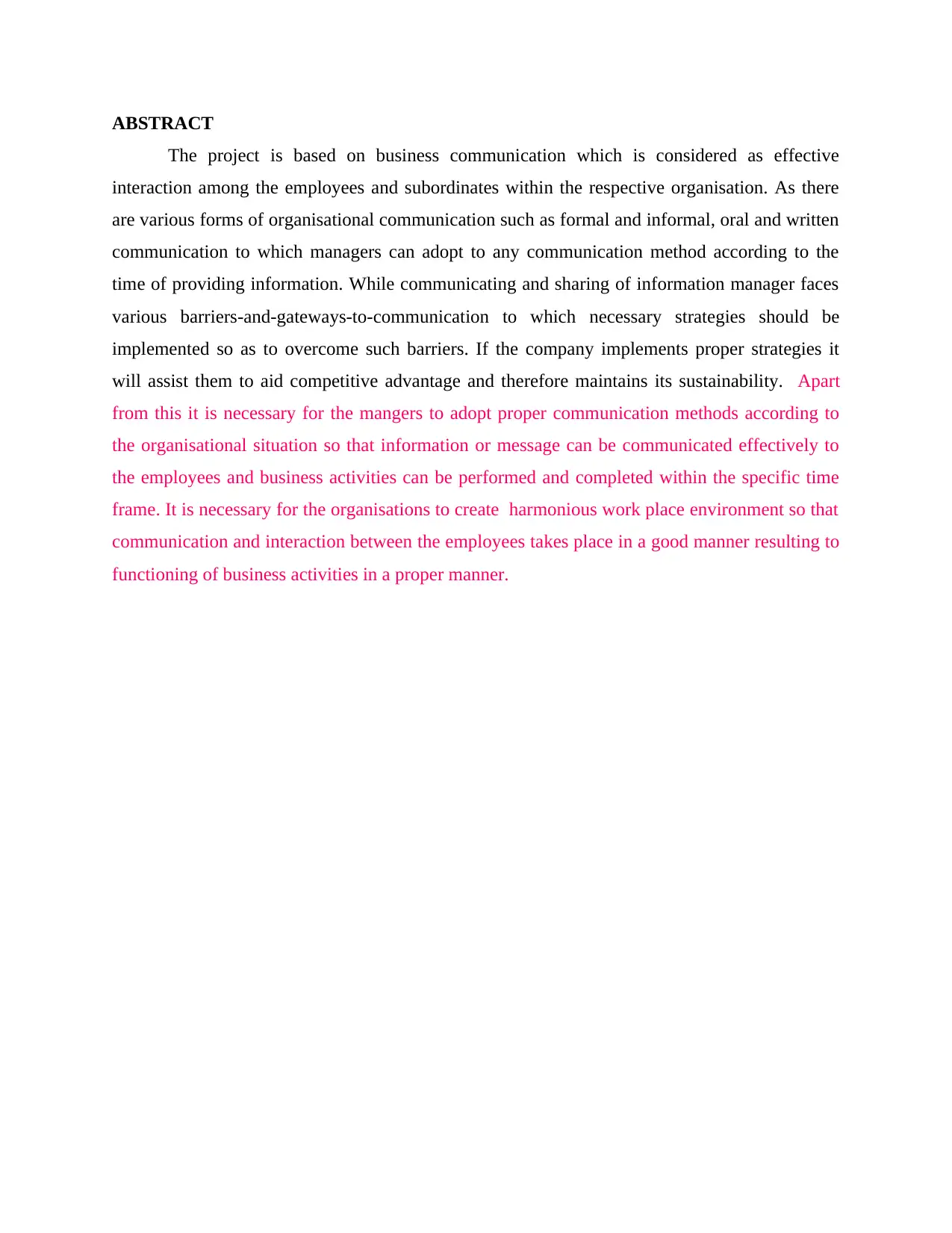
ABSTRACT
The project is based on business communication which is considered as effective
interaction among the employees and subordinates within the respective organisation. As there
are various forms of organisational communication such as formal and informal, oral and written
communication to which managers can adopt to any communication method according to the
time of providing information. While communicating and sharing of information manager faces
various barriers-and-gateways-to-communication to which necessary strategies should be
implemented so as to overcome such barriers. If the company implements proper strategies it
will assist them to aid competitive advantage and therefore maintains its sustainability. Apart
from this it is necessary for the mangers to adopt proper communication methods according to
the organisational situation so that information or message can be communicated effectively to
the employees and business activities can be performed and completed within the specific time
frame. It is necessary for the organisations to create harmonious work place environment so that
communication and interaction between the employees takes place in a good manner resulting to
functioning of business activities in a proper manner.
The project is based on business communication which is considered as effective
interaction among the employees and subordinates within the respective organisation. As there
are various forms of organisational communication such as formal and informal, oral and written
communication to which managers can adopt to any communication method according to the
time of providing information. While communicating and sharing of information manager faces
various barriers-and-gateways-to-communication to which necessary strategies should be
implemented so as to overcome such barriers. If the company implements proper strategies it
will assist them to aid competitive advantage and therefore maintains its sustainability. Apart
from this it is necessary for the mangers to adopt proper communication methods according to
the organisational situation so that information or message can be communicated effectively to
the employees and business activities can be performed and completed within the specific time
frame. It is necessary for the organisations to create harmonious work place environment so that
communication and interaction between the employees takes place in a good manner resulting to
functioning of business activities in a proper manner.
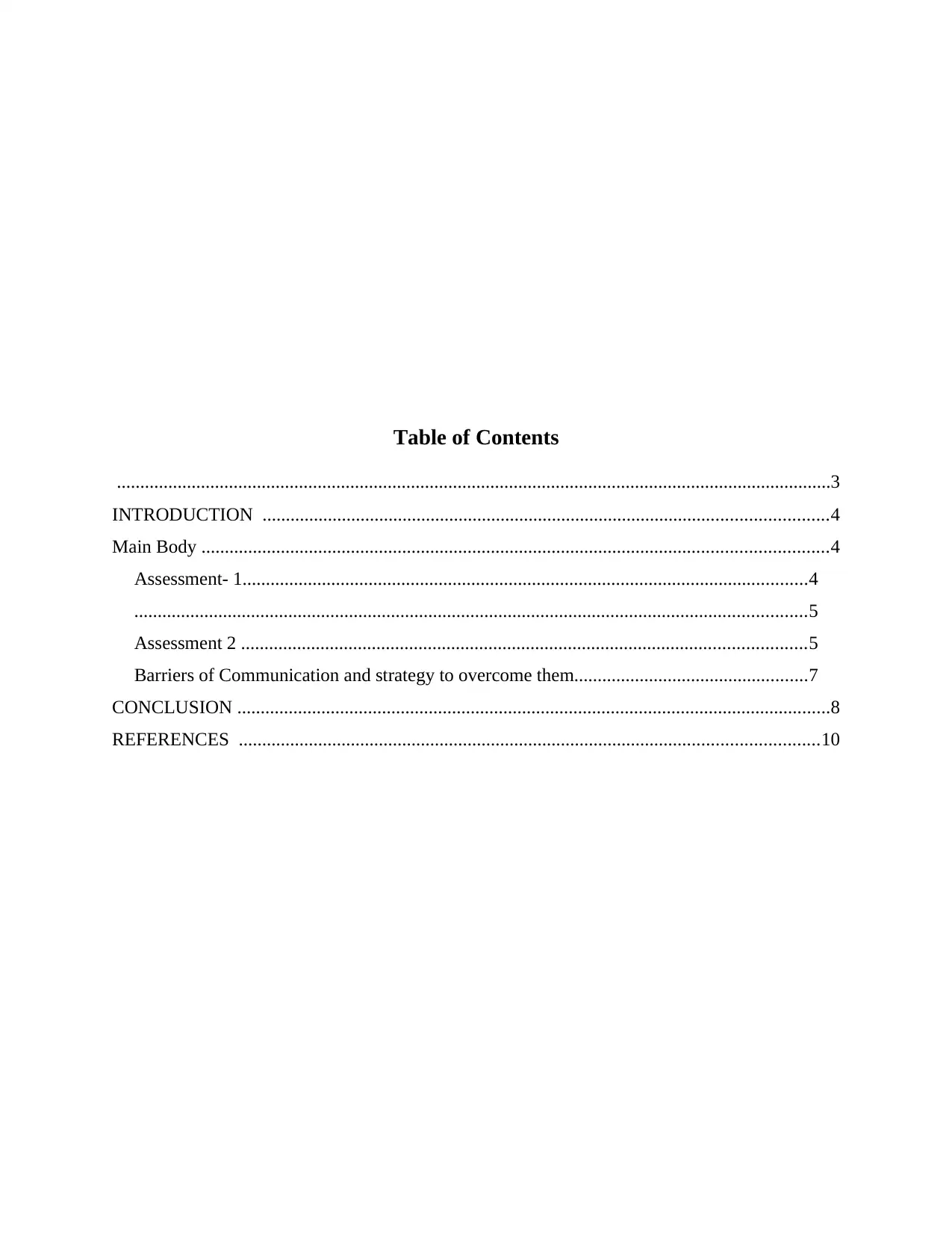
Table of Contents
.........................................................................................................................................................3
INTRODUCTION .........................................................................................................................4
Main Body ......................................................................................................................................4
Assessment- 1.........................................................................................................................4
................................................................................................................................................5
Assessment 2 .........................................................................................................................5
Barriers of Communication and strategy to overcome them..................................................7
CONCLUSION ...............................................................................................................................8
REFERENCES ............................................................................................................................10
.........................................................................................................................................................3
INTRODUCTION .........................................................................................................................4
Main Body ......................................................................................................................................4
Assessment- 1.........................................................................................................................4
................................................................................................................................................5
Assessment 2 .........................................................................................................................5
Barriers of Communication and strategy to overcome them..................................................7
CONCLUSION ...............................................................................................................................8
REFERENCES ............................................................................................................................10
⊘ This is a preview!⊘
Do you want full access?
Subscribe today to unlock all pages.

Trusted by 1+ million students worldwide
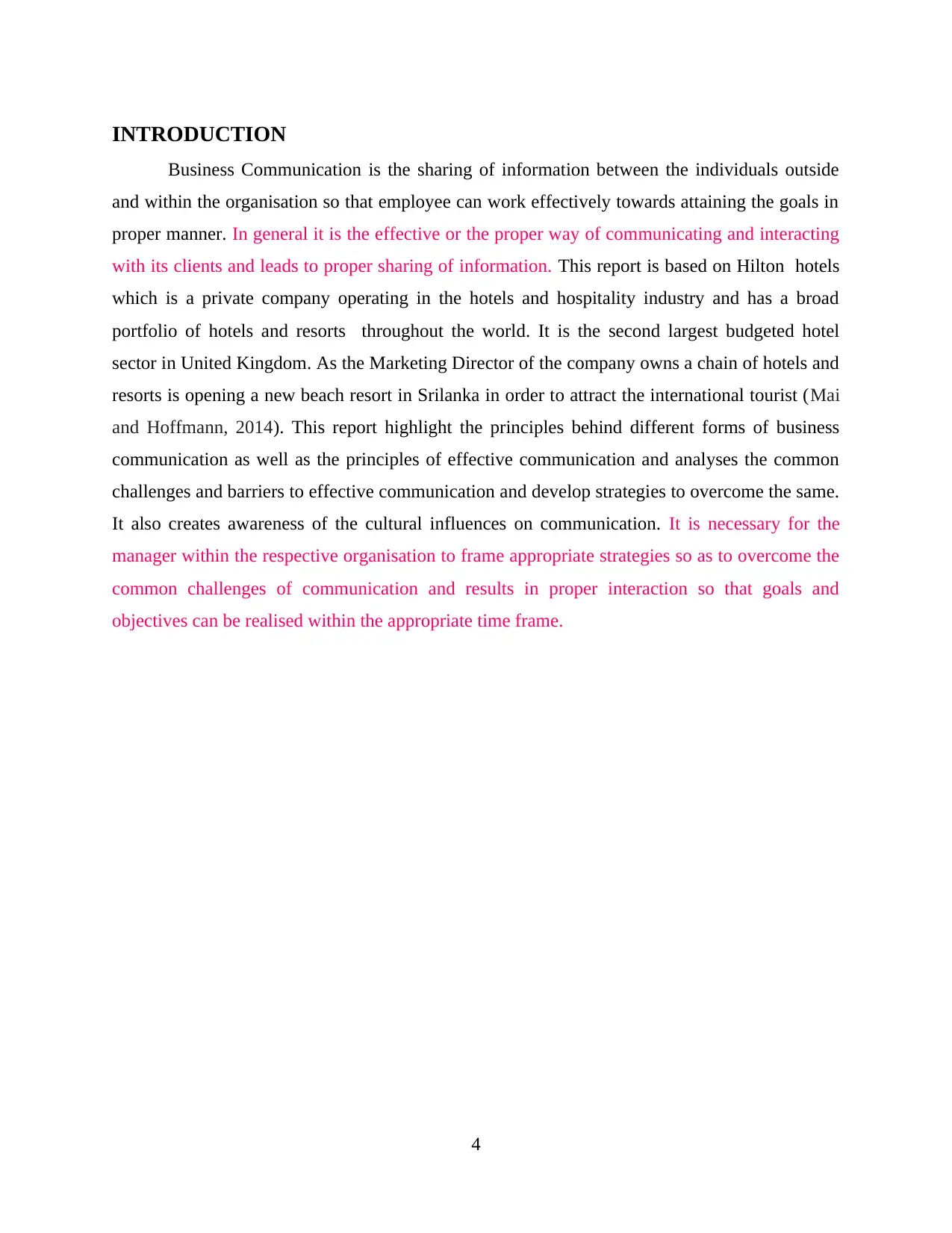
INTRODUCTION
Business Communication is the sharing of information between the individuals outside
and within the organisation so that employee can work effectively towards attaining the goals in
proper manner. In general it is the effective or the proper way of communicating and interacting
with its clients and leads to proper sharing of information. This report is based on Hilton hotels
which is a private company operating in the hotels and hospitality industry and has a broad
portfolio of hotels and resorts throughout the world. It is the second largest budgeted hotel
sector in United Kingdom. As the Marketing Director of the company owns a chain of hotels and
resorts is opening a new beach resort in Srilanka in order to attract the international tourist (Mai
and Hoffmann, 2014). This report highlight the principles behind different forms of business
communication as well as the principles of effective communication and analyses the common
challenges and barriers to effective communication and develop strategies to overcome the same.
It also creates awareness of the cultural influences on communication. It is necessary for the
manager within the respective organisation to frame appropriate strategies so as to overcome the
common challenges of communication and results in proper interaction so that goals and
objectives can be realised within the appropriate time frame.
4
Business Communication is the sharing of information between the individuals outside
and within the organisation so that employee can work effectively towards attaining the goals in
proper manner. In general it is the effective or the proper way of communicating and interacting
with its clients and leads to proper sharing of information. This report is based on Hilton hotels
which is a private company operating in the hotels and hospitality industry and has a broad
portfolio of hotels and resorts throughout the world. It is the second largest budgeted hotel
sector in United Kingdom. As the Marketing Director of the company owns a chain of hotels and
resorts is opening a new beach resort in Srilanka in order to attract the international tourist (Mai
and Hoffmann, 2014). This report highlight the principles behind different forms of business
communication as well as the principles of effective communication and analyses the common
challenges and barriers to effective communication and develop strategies to overcome the same.
It also creates awareness of the cultural influences on communication. It is necessary for the
manager within the respective organisation to frame appropriate strategies so as to overcome the
common challenges of communication and results in proper interaction so that goals and
objectives can be realised within the appropriate time frame.
4
Paraphrase This Document
Need a fresh take? Get an instant paraphrase of this document with our AI Paraphraser
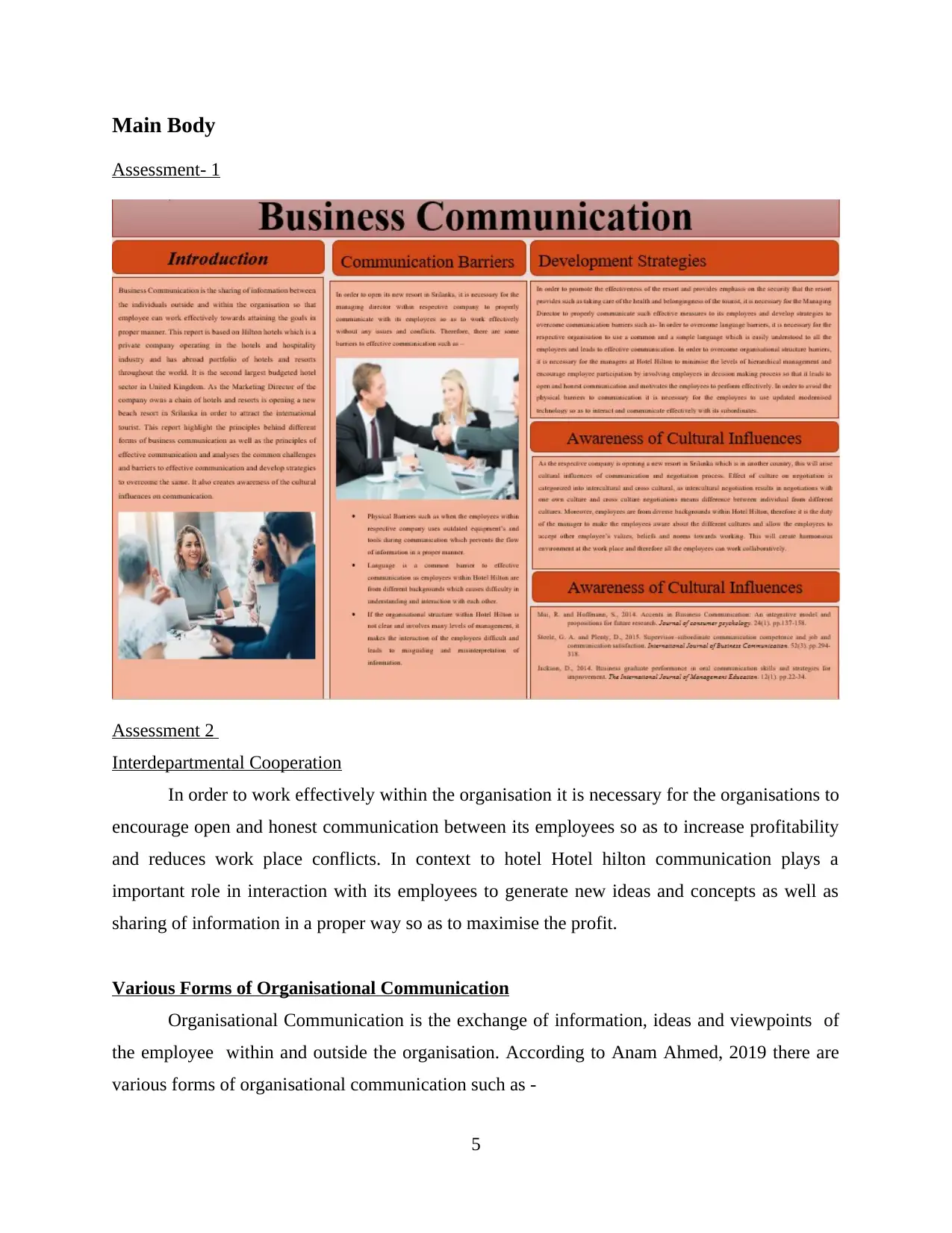
Main Body
Assessment- 1
Assessment 2
Interdepartmental Cooperation
In order to work effectively within the organisation it is necessary for the organisations to
encourage open and honest communication between its employees so as to increase profitability
and reduces work place conflicts. In context to hotel Hotel hilton communication plays a
important role in interaction with its employees to generate new ideas and concepts as well as
sharing of information in a proper way so as to maximise the profit.
Various Forms of Organisational Communication
Organisational Communication is the exchange of information, ideas and viewpoints of
the employee within and outside the organisation. According to Anam Ahmed, 2019 there are
various forms of organisational communication such as -
5
Assessment- 1
Assessment 2
Interdepartmental Cooperation
In order to work effectively within the organisation it is necessary for the organisations to
encourage open and honest communication between its employees so as to increase profitability
and reduces work place conflicts. In context to hotel Hotel hilton communication plays a
important role in interaction with its employees to generate new ideas and concepts as well as
sharing of information in a proper way so as to maximise the profit.
Various Forms of Organisational Communication
Organisational Communication is the exchange of information, ideas and viewpoints of
the employee within and outside the organisation. According to Anam Ahmed, 2019 there are
various forms of organisational communication such as -
5
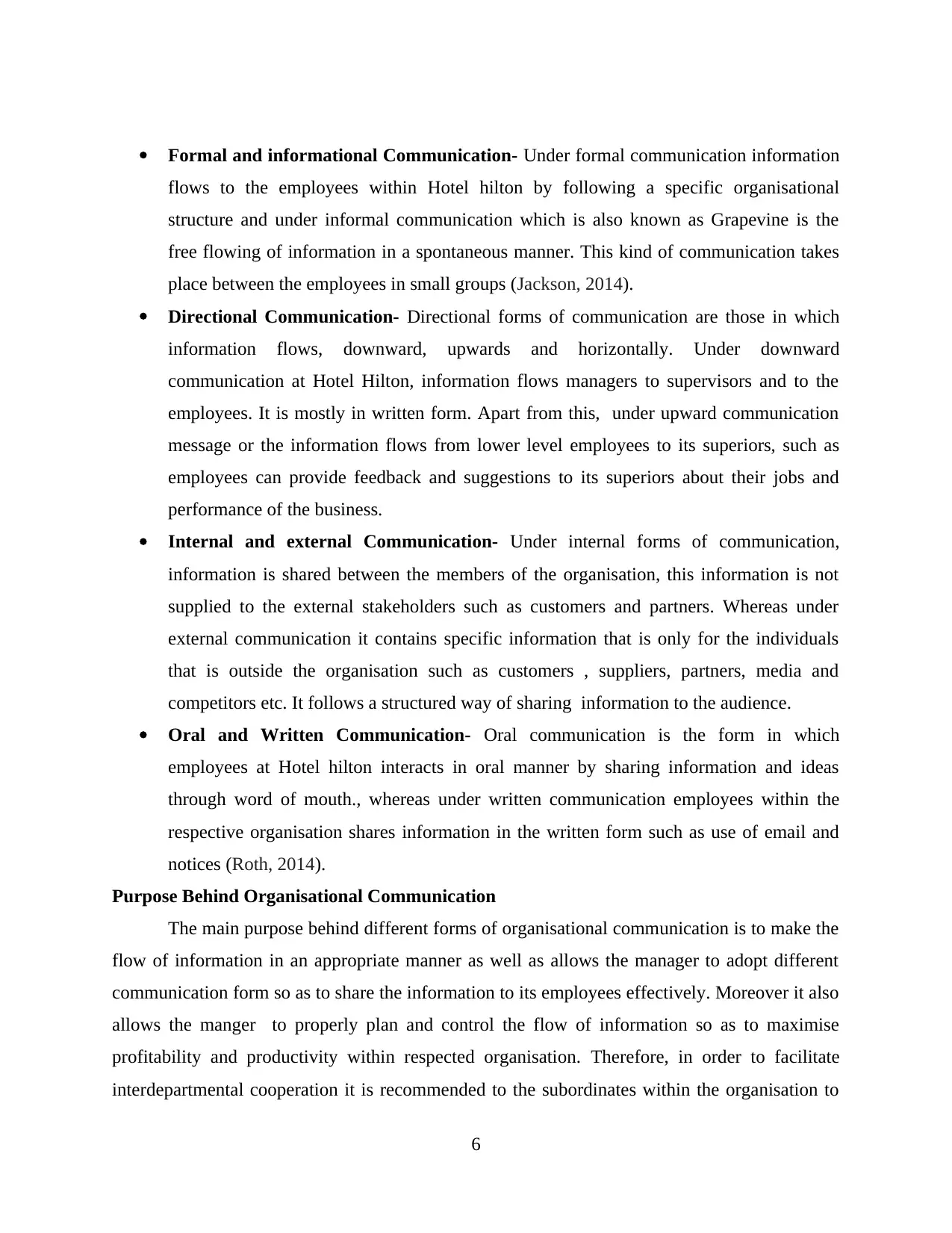
Formal and informational Communication- Under formal communication information
flows to the employees within Hotel hilton by following a specific organisational
structure and under informal communication which is also known as Grapevine is the
free flowing of information in a spontaneous manner. This kind of communication takes
place between the employees in small groups (Jackson, 2014).
Directional Communication- Directional forms of communication are those in which
information flows, downward, upwards and horizontally. Under downward
communication at Hotel Hilton, information flows managers to supervisors and to the
employees. It is mostly in written form. Apart from this, under upward communication
message or the information flows from lower level employees to its superiors, such as
employees can provide feedback and suggestions to its superiors about their jobs and
performance of the business.
Internal and external Communication- Under internal forms of communication,
information is shared between the members of the organisation, this information is not
supplied to the external stakeholders such as customers and partners. Whereas under
external communication it contains specific information that is only for the individuals
that is outside the organisation such as customers , suppliers, partners, media and
competitors etc. It follows a structured way of sharing information to the audience.
Oral and Written Communication- Oral communication is the form in which
employees at Hotel hilton interacts in oral manner by sharing information and ideas
through word of mouth., whereas under written communication employees within the
respective organisation shares information in the written form such as use of email and
notices (Roth, 2014).
Purpose Behind Organisational Communication
The main purpose behind different forms of organisational communication is to make the
flow of information in an appropriate manner as well as allows the manager to adopt different
communication form so as to share the information to its employees effectively. Moreover it also
allows the manger to properly plan and control the flow of information so as to maximise
profitability and productivity within respected organisation. Therefore, in order to facilitate
interdepartmental cooperation it is recommended to the subordinates within the organisation to
6
flows to the employees within Hotel hilton by following a specific organisational
structure and under informal communication which is also known as Grapevine is the
free flowing of information in a spontaneous manner. This kind of communication takes
place between the employees in small groups (Jackson, 2014).
Directional Communication- Directional forms of communication are those in which
information flows, downward, upwards and horizontally. Under downward
communication at Hotel Hilton, information flows managers to supervisors and to the
employees. It is mostly in written form. Apart from this, under upward communication
message or the information flows from lower level employees to its superiors, such as
employees can provide feedback and suggestions to its superiors about their jobs and
performance of the business.
Internal and external Communication- Under internal forms of communication,
information is shared between the members of the organisation, this information is not
supplied to the external stakeholders such as customers and partners. Whereas under
external communication it contains specific information that is only for the individuals
that is outside the organisation such as customers , suppliers, partners, media and
competitors etc. It follows a structured way of sharing information to the audience.
Oral and Written Communication- Oral communication is the form in which
employees at Hotel hilton interacts in oral manner by sharing information and ideas
through word of mouth., whereas under written communication employees within the
respective organisation shares information in the written form such as use of email and
notices (Roth, 2014).
Purpose Behind Organisational Communication
The main purpose behind different forms of organisational communication is to make the
flow of information in an appropriate manner as well as allows the manager to adopt different
communication form so as to share the information to its employees effectively. Moreover it also
allows the manger to properly plan and control the flow of information so as to maximise
profitability and productivity within respected organisation. Therefore, in order to facilitate
interdepartmental cooperation it is recommended to the subordinates within the organisation to
6
⊘ This is a preview!⊘
Do you want full access?
Subscribe today to unlock all pages.

Trusted by 1+ million students worldwide
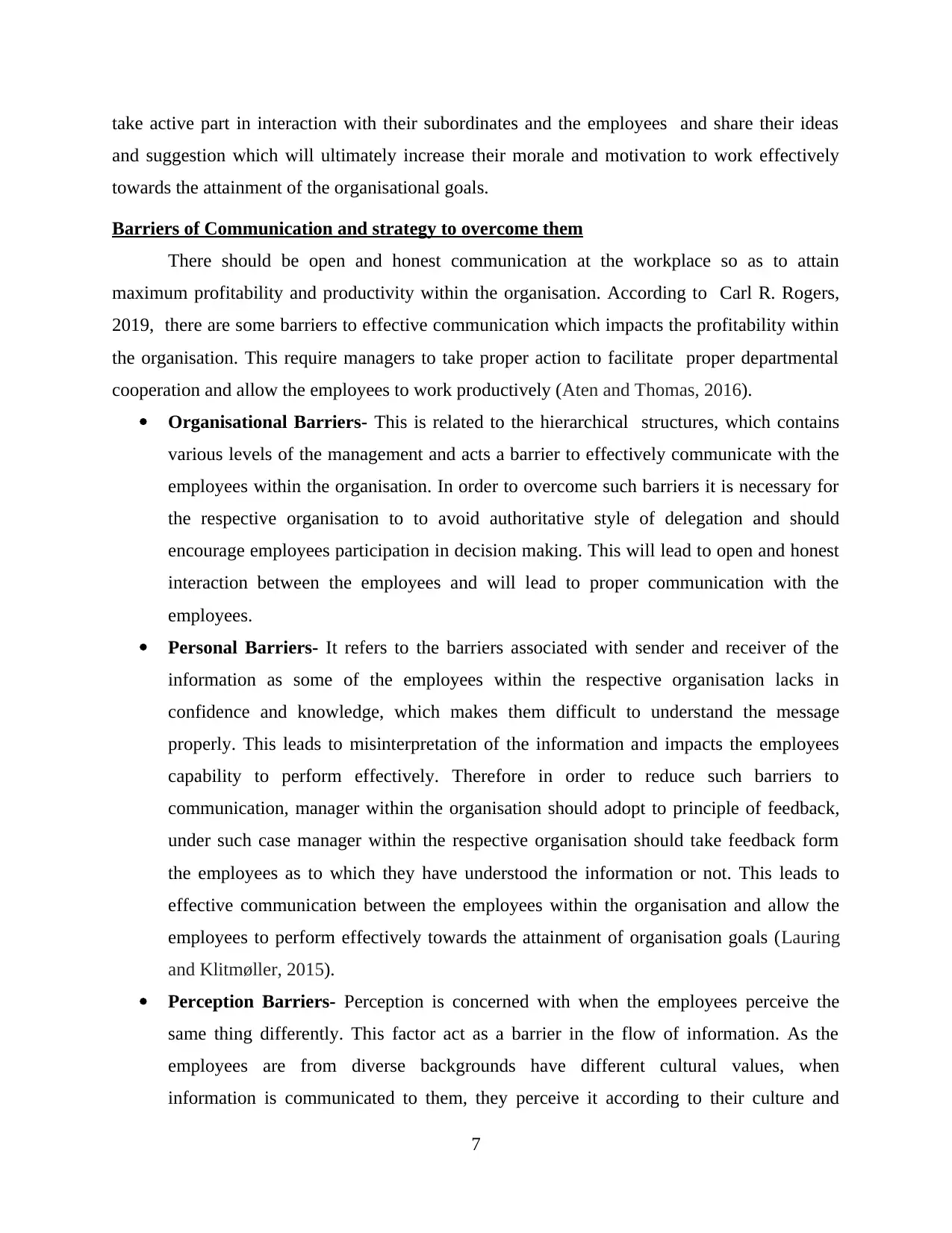
take active part in interaction with their subordinates and the employees and share their ideas
and suggestion which will ultimately increase their morale and motivation to work effectively
towards the attainment of the organisational goals.
Barriers of Communication and strategy to overcome them
There should be open and honest communication at the workplace so as to attain
maximum profitability and productivity within the organisation. According to Carl R. Rogers,
2019, there are some barriers to effective communication which impacts the profitability within
the organisation. This require managers to take proper action to facilitate proper departmental
cooperation and allow the employees to work productively (Aten and Thomas, 2016).
Organisational Barriers- This is related to the hierarchical structures, which contains
various levels of the management and acts a barrier to effectively communicate with the
employees within the organisation. In order to overcome such barriers it is necessary for
the respective organisation to to avoid authoritative style of delegation and should
encourage employees participation in decision making. This will lead to open and honest
interaction between the employees and will lead to proper communication with the
employees.
Personal Barriers- It refers to the barriers associated with sender and receiver of the
information as some of the employees within the respective organisation lacks in
confidence and knowledge, which makes them difficult to understand the message
properly. This leads to misinterpretation of the information and impacts the employees
capability to perform effectively. Therefore in order to reduce such barriers to
communication, manager within the organisation should adopt to principle of feedback,
under such case manager within the respective organisation should take feedback form
the employees as to which they have understood the information or not. This leads to
effective communication between the employees within the organisation and allow the
employees to perform effectively towards the attainment of organisation goals (Lauring
and Klitmøller, 2015).
Perception Barriers- Perception is concerned with when the employees perceive the
same thing differently. This factor act as a barrier in the flow of information. As the
employees are from diverse backgrounds have different cultural values, when
information is communicated to them, they perceive it according to their culture and
7
and suggestion which will ultimately increase their morale and motivation to work effectively
towards the attainment of the organisational goals.
Barriers of Communication and strategy to overcome them
There should be open and honest communication at the workplace so as to attain
maximum profitability and productivity within the organisation. According to Carl R. Rogers,
2019, there are some barriers to effective communication which impacts the profitability within
the organisation. This require managers to take proper action to facilitate proper departmental
cooperation and allow the employees to work productively (Aten and Thomas, 2016).
Organisational Barriers- This is related to the hierarchical structures, which contains
various levels of the management and acts a barrier to effectively communicate with the
employees within the organisation. In order to overcome such barriers it is necessary for
the respective organisation to to avoid authoritative style of delegation and should
encourage employees participation in decision making. This will lead to open and honest
interaction between the employees and will lead to proper communication with the
employees.
Personal Barriers- It refers to the barriers associated with sender and receiver of the
information as some of the employees within the respective organisation lacks in
confidence and knowledge, which makes them difficult to understand the message
properly. This leads to misinterpretation of the information and impacts the employees
capability to perform effectively. Therefore in order to reduce such barriers to
communication, manager within the organisation should adopt to principle of feedback,
under such case manager within the respective organisation should take feedback form
the employees as to which they have understood the information or not. This leads to
effective communication between the employees within the organisation and allow the
employees to perform effectively towards the attainment of organisation goals (Lauring
and Klitmøller, 2015).
Perception Barriers- Perception is concerned with when the employees perceive the
same thing differently. This factor act as a barrier in the flow of information. As the
employees are from diverse backgrounds have different cultural values, when
information is communicated to them, they perceive it according to their culture and
7
Paraphrase This Document
Need a fresh take? Get an instant paraphrase of this document with our AI Paraphraser
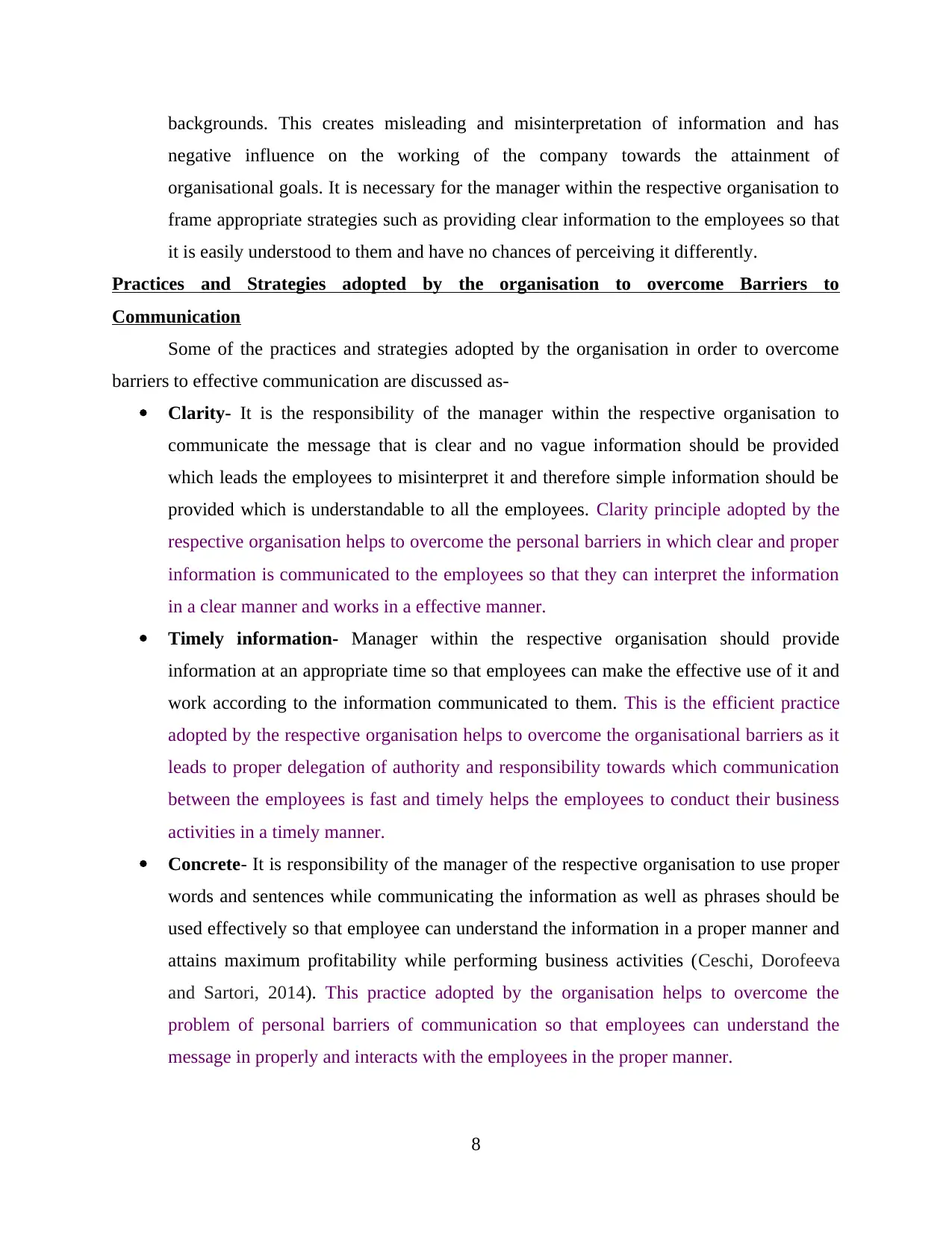
backgrounds. This creates misleading and misinterpretation of information and has
negative influence on the working of the company towards the attainment of
organisational goals. It is necessary for the manager within the respective organisation to
frame appropriate strategies such as providing clear information to the employees so that
it is easily understood to them and have no chances of perceiving it differently.
Practices and Strategies adopted by the organisation to overcome Barriers to
Communication
Some of the practices and strategies adopted by the organisation in order to overcome
barriers to effective communication are discussed as-
Clarity- It is the responsibility of the manager within the respective organisation to
communicate the message that is clear and no vague information should be provided
which leads the employees to misinterpret it and therefore simple information should be
provided which is understandable to all the employees. Clarity principle adopted by the
respective organisation helps to overcome the personal barriers in which clear and proper
information is communicated to the employees so that they can interpret the information
in a clear manner and works in a effective manner.
Timely information- Manager within the respective organisation should provide
information at an appropriate time so that employees can make the effective use of it and
work according to the information communicated to them. This is the efficient practice
adopted by the respective organisation helps to overcome the organisational barriers as it
leads to proper delegation of authority and responsibility towards which communication
between the employees is fast and timely helps the employees to conduct their business
activities in a timely manner.
Concrete- It is responsibility of the manager of the respective organisation to use proper
words and sentences while communicating the information as well as phrases should be
used effectively so that employee can understand the information in a proper manner and
attains maximum profitability while performing business activities (Ceschi, Dorofeeva
and Sartori, 2014). This practice adopted by the organisation helps to overcome the
problem of personal barriers of communication so that employees can understand the
message in properly and interacts with the employees in the proper manner.
8
negative influence on the working of the company towards the attainment of
organisational goals. It is necessary for the manager within the respective organisation to
frame appropriate strategies such as providing clear information to the employees so that
it is easily understood to them and have no chances of perceiving it differently.
Practices and Strategies adopted by the organisation to overcome Barriers to
Communication
Some of the practices and strategies adopted by the organisation in order to overcome
barriers to effective communication are discussed as-
Clarity- It is the responsibility of the manager within the respective organisation to
communicate the message that is clear and no vague information should be provided
which leads the employees to misinterpret it and therefore simple information should be
provided which is understandable to all the employees. Clarity principle adopted by the
respective organisation helps to overcome the personal barriers in which clear and proper
information is communicated to the employees so that they can interpret the information
in a clear manner and works in a effective manner.
Timely information- Manager within the respective organisation should provide
information at an appropriate time so that employees can make the effective use of it and
work according to the information communicated to them. This is the efficient practice
adopted by the respective organisation helps to overcome the organisational barriers as it
leads to proper delegation of authority and responsibility towards which communication
between the employees is fast and timely helps the employees to conduct their business
activities in a timely manner.
Concrete- It is responsibility of the manager of the respective organisation to use proper
words and sentences while communicating the information as well as phrases should be
used effectively so that employee can understand the information in a proper manner and
attains maximum profitability while performing business activities (Ceschi, Dorofeeva
and Sartori, 2014). This practice adopted by the organisation helps to overcome the
problem of personal barriers of communication so that employees can understand the
message in properly and interacts with the employees in the proper manner.
8
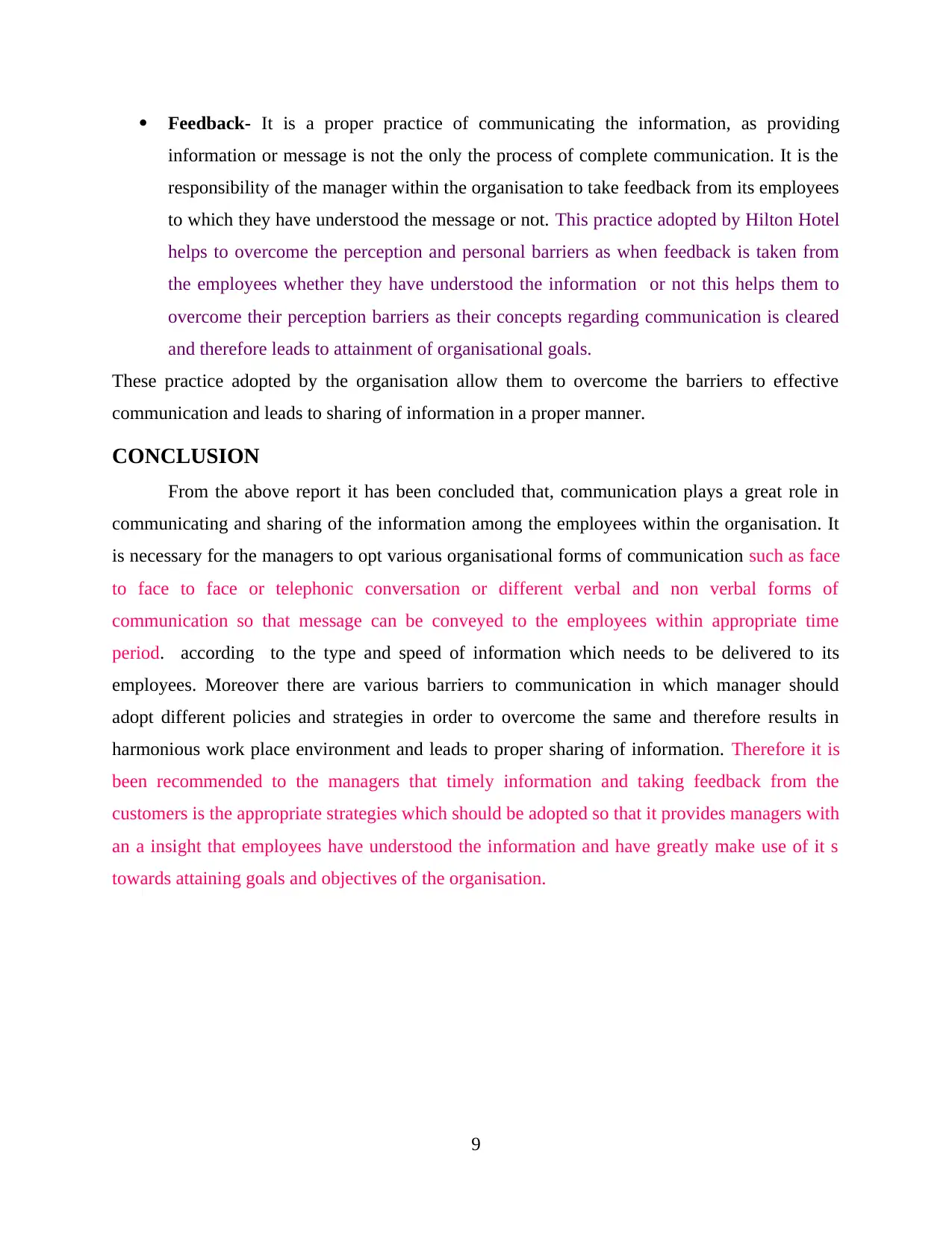
Feedback- It is a proper practice of communicating the information, as providing
information or message is not the only the process of complete communication. It is the
responsibility of the manager within the organisation to take feedback from its employees
to which they have understood the message or not. This practice adopted by Hilton Hotel
helps to overcome the perception and personal barriers as when feedback is taken from
the employees whether they have understood the information or not this helps them to
overcome their perception barriers as their concepts regarding communication is cleared
and therefore leads to attainment of organisational goals.
These practice adopted by the organisation allow them to overcome the barriers to effective
communication and leads to sharing of information in a proper manner.
CONCLUSION
From the above report it has been concluded that, communication plays a great role in
communicating and sharing of the information among the employees within the organisation. It
is necessary for the managers to opt various organisational forms of communication such as face
to face to face or telephonic conversation or different verbal and non verbal forms of
communication so that message can be conveyed to the employees within appropriate time
period. according to the type and speed of information which needs to be delivered to its
employees. Moreover there are various barriers to communication in which manager should
adopt different policies and strategies in order to overcome the same and therefore results in
harmonious work place environment and leads to proper sharing of information. Therefore it is
been recommended to the managers that timely information and taking feedback from the
customers is the appropriate strategies which should be adopted so that it provides managers with
an a insight that employees have understood the information and have greatly make use of it s
towards attaining goals and objectives of the organisation.
9
information or message is not the only the process of complete communication. It is the
responsibility of the manager within the organisation to take feedback from its employees
to which they have understood the message or not. This practice adopted by Hilton Hotel
helps to overcome the perception and personal barriers as when feedback is taken from
the employees whether they have understood the information or not this helps them to
overcome their perception barriers as their concepts regarding communication is cleared
and therefore leads to attainment of organisational goals.
These practice adopted by the organisation allow them to overcome the barriers to effective
communication and leads to sharing of information in a proper manner.
CONCLUSION
From the above report it has been concluded that, communication plays a great role in
communicating and sharing of the information among the employees within the organisation. It
is necessary for the managers to opt various organisational forms of communication such as face
to face to face or telephonic conversation or different verbal and non verbal forms of
communication so that message can be conveyed to the employees within appropriate time
period. according to the type and speed of information which needs to be delivered to its
employees. Moreover there are various barriers to communication in which manager should
adopt different policies and strategies in order to overcome the same and therefore results in
harmonious work place environment and leads to proper sharing of information. Therefore it is
been recommended to the managers that timely information and taking feedback from the
customers is the appropriate strategies which should be adopted so that it provides managers with
an a insight that employees have understood the information and have greatly make use of it s
towards attaining goals and objectives of the organisation.
9
⊘ This is a preview!⊘
Do you want full access?
Subscribe today to unlock all pages.

Trusted by 1+ million students worldwide

10
Paraphrase This Document
Need a fresh take? Get an instant paraphrase of this document with our AI Paraphraser
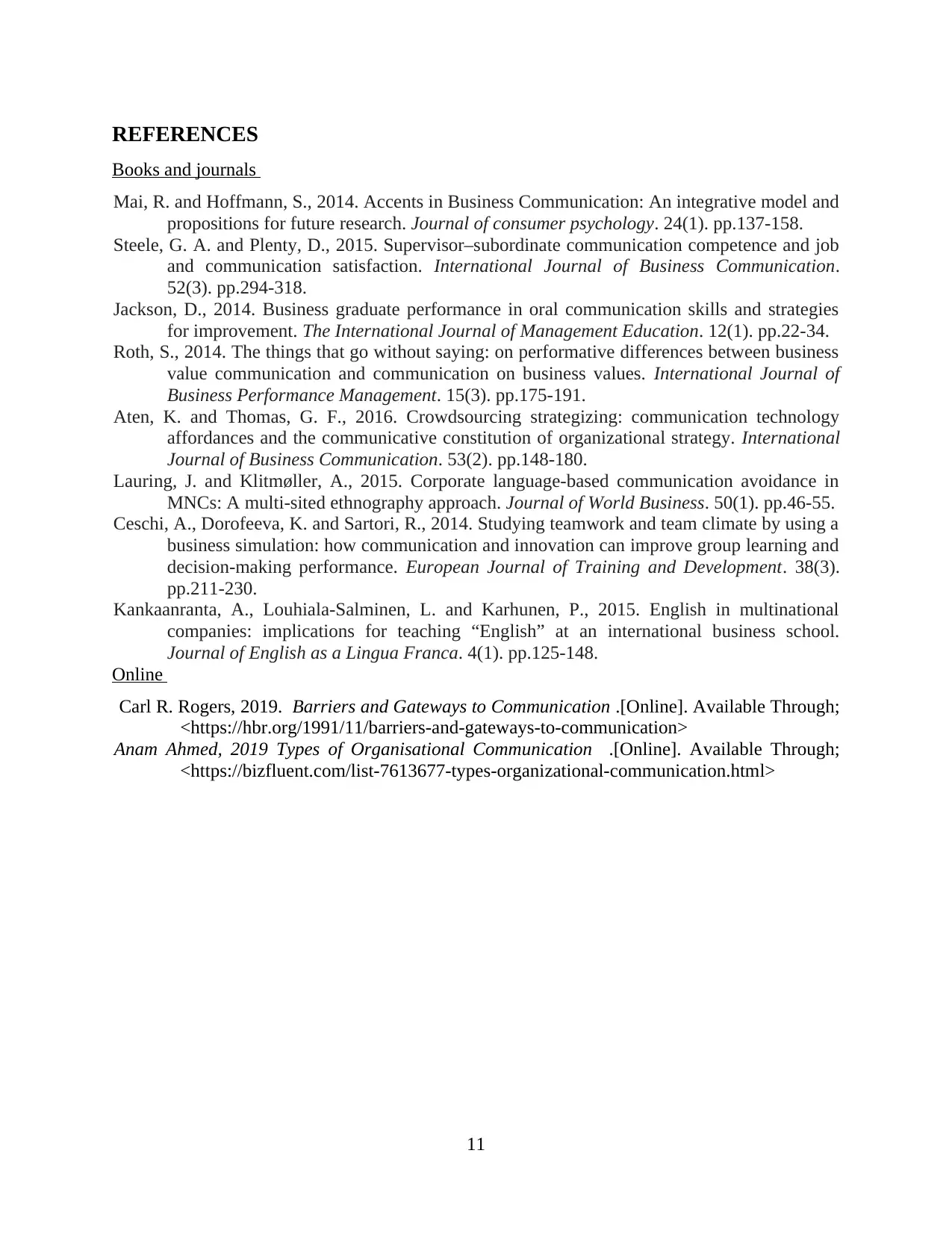
REFERENCES
Books and journals
Mai, R. and Hoffmann, S., 2014. Accents in Business Communication: An integrative model and
propositions for future research. Journal of consumer psychology. 24(1). pp.137-158.
Steele, G. A. and Plenty, D., 2015. Supervisor–subordinate communication competence and job
and communication satisfaction. International Journal of Business Communication.
52(3). pp.294-318.
Jackson, D., 2014. Business graduate performance in oral communication skills and strategies
for improvement. The International Journal of Management Education. 12(1). pp.22-34.
Roth, S., 2014. The things that go without saying: on performative differences between business
value communication and communication on business values. International Journal of
Business Performance Management. 15(3). pp.175-191.
Aten, K. and Thomas, G. F., 2016. Crowdsourcing strategizing: communication technology
affordances and the communicative constitution of organizational strategy. International
Journal of Business Communication. 53(2). pp.148-180.
Lauring, J. and Klitmøller, A., 2015. Corporate language-based communication avoidance in
MNCs: A multi-sited ethnography approach. Journal of World Business. 50(1). pp.46-55.
Ceschi, A., Dorofeeva, K. and Sartori, R., 2014. Studying teamwork and team climate by using a
business simulation: how communication and innovation can improve group learning and
decision-making performance. European Journal of Training and Development. 38(3).
pp.211-230.
Kankaanranta, A., Louhiala-Salminen, L. and Karhunen, P., 2015. English in multinational
companies: implications for teaching “English” at an international business school.
Journal of English as a Lingua Franca. 4(1). pp.125-148.
Online
Carl R. Rogers, 2019. Barriers and Gateways to Communication .[Online]. Available Through;
<https://hbr.org/1991/11/barriers-and-gateways-to-communication>
Anam Ahmed, 2019 Types of Organisational Communication .[Online]. Available Through;
<https://bizfluent.com/list-7613677-types-organizational-communication.html>
11
Books and journals
Mai, R. and Hoffmann, S., 2014. Accents in Business Communication: An integrative model and
propositions for future research. Journal of consumer psychology. 24(1). pp.137-158.
Steele, G. A. and Plenty, D., 2015. Supervisor–subordinate communication competence and job
and communication satisfaction. International Journal of Business Communication.
52(3). pp.294-318.
Jackson, D., 2014. Business graduate performance in oral communication skills and strategies
for improvement. The International Journal of Management Education. 12(1). pp.22-34.
Roth, S., 2014. The things that go without saying: on performative differences between business
value communication and communication on business values. International Journal of
Business Performance Management. 15(3). pp.175-191.
Aten, K. and Thomas, G. F., 2016. Crowdsourcing strategizing: communication technology
affordances and the communicative constitution of organizational strategy. International
Journal of Business Communication. 53(2). pp.148-180.
Lauring, J. and Klitmøller, A., 2015. Corporate language-based communication avoidance in
MNCs: A multi-sited ethnography approach. Journal of World Business. 50(1). pp.46-55.
Ceschi, A., Dorofeeva, K. and Sartori, R., 2014. Studying teamwork and team climate by using a
business simulation: how communication and innovation can improve group learning and
decision-making performance. European Journal of Training and Development. 38(3).
pp.211-230.
Kankaanranta, A., Louhiala-Salminen, L. and Karhunen, P., 2015. English in multinational
companies: implications for teaching “English” at an international business school.
Journal of English as a Lingua Franca. 4(1). pp.125-148.
Online
Carl R. Rogers, 2019. Barriers and Gateways to Communication .[Online]. Available Through;
<https://hbr.org/1991/11/barriers-and-gateways-to-communication>
Anam Ahmed, 2019 Types of Organisational Communication .[Online]. Available Through;
<https://bizfluent.com/list-7613677-types-organizational-communication.html>
11
1 out of 11
Related Documents
Your All-in-One AI-Powered Toolkit for Academic Success.
+13062052269
info@desklib.com
Available 24*7 on WhatsApp / Email
![[object Object]](/_next/static/media/star-bottom.7253800d.svg)
Unlock your academic potential
Copyright © 2020–2025 A2Z Services. All Rights Reserved. Developed and managed by ZUCOL.





